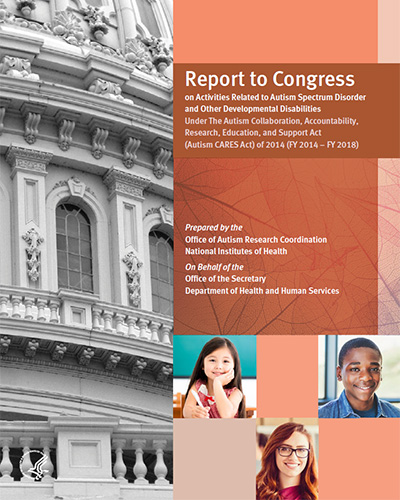Report to Congress
on Activities Related to Autism Spectrum Disorder and Other Developmental Disabilities
FY 2014 - FY 2018
Average Age for Intervention
This section addresses subsection (E) of 399DD: "Information on the average age for intervention for individuals diagnosed with autism spectrum disorder and other developmental disabilities, including how that age may have changed over the 4-year period beginning on August 8, 2014, and, as appropriate, how this age varies across population subgroups." Information on the average age of intervention for individuals with ASD is provided by the CDC.
Centers for Disease Control and Prevention
Early identification and service initiation play an important role in the expression and progression of ASD. One of the goals of the Healthy People 2020 (HP2020) initiative on Maternal, Infant, and Child Health is to increase the proportion of children with ASD enrolled in special services by 48 months of age. More specifically, the HP2020 target was set to 57.6%, reflecting a 10% increase from baseline year 2006. CDC does not collect information on average age of intervention for individuals diagnosed with ASD and other DD through their ADDM Network; however, data from the Metropolitan Atlanta Developmental Disabilities Surveillance Program (MADDSP) at CDC are linked to special education data to estimate the percentage of children with ASD who begin receiving special education services by age 48 months. According to data from MADDSP, initiation of special education services by 48 months of age among children with ASD reached 52.4% in 2006, 51.5% in 2008, 52.0% in 2010, and dropped to 46.4% in 2012. The trend was similar among males-only, remaining close to 50% from 2006 to 2010, and then dropping to 46.9% in 2012. Among females, the proportion reached a high of 65.5% in 2008, but gradually decreased to a low of 44.2% in 2012. With regard to race/ethnicity, non-Hispanic whites had the highest proportion of early service initiation almost at any given time-point (ranging from 47.1% in 2012 to 58.4% in 2008), followed by non-Hispanic blacks (ranging from 49.3% in 2008 to 52.7% in 2006), and Hispanics (ranging from 35.5% in 2008 to 49.3% in 2010). CDC will continue to monitor progress towards this goal and provide input into the development of the HP2030 goals.




